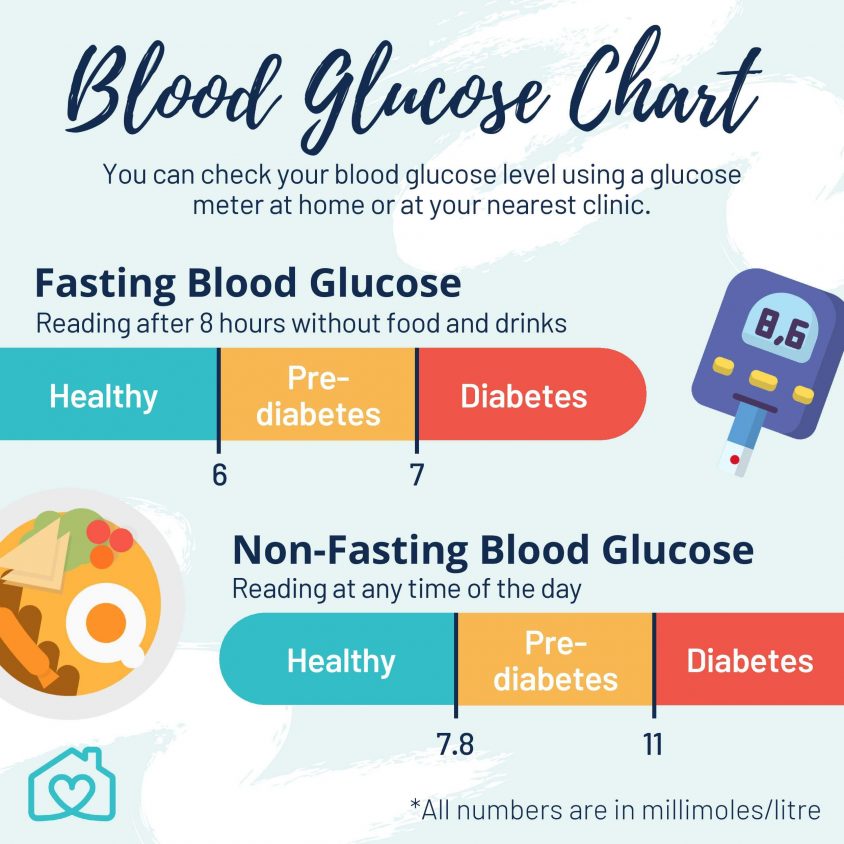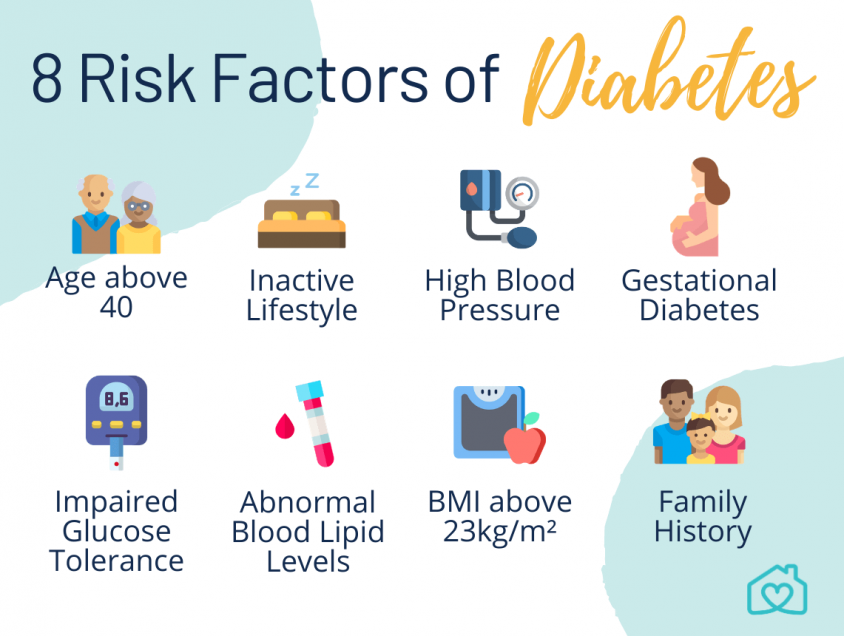Diabetes facts you need to know
According to the Australian Institute of Health and Welfare, 4.9% of Australians reported having diabetes in 2017-2018, with around 1.2 million hospitalisations associated with diabetes around the same time period.
Facing these sobering statistics, it is important for us to understand more about this condition, our risk factors, and useful tips to prevent diabetes.
What is Diabetes?
Diabetes occurs when our body is unable to produce enough insulin or does not use insulin effectively. This results in high glucose levels, as insulin is the hormone that helps us turn blood glucose into energy. While diabetes itself is not life-threatening, it leads to various health complications if not well-managed.
Healthy blood glucose levels range between 4 mmol/l to 7.8 mmol/l, and having a blood glucose level higher than 11mmol/l is a possible indication of diabetes.

Before diabetes strikes, there is a stage where some would find themselves in — pre-diabetes. Pre-diabetes occurs when your blood sugar levels are higher than normal but insufficient to be diagnosed as type 2 diabetes. Having pre-diabetes could increase our chances of developing type 2 diabetes, heart diseases and stroke.
The good news is pre-diabetes can be reversed with lifestyle changes, such as a healthier diet and regular exercise. Learn more about how you can reverse pre-diabetes here. Diabetes itself, however, cannot be reversed or cured and would need to be managed well to prevent further health complications.
The Different Types of Diabetes
You may have heard of the different types of diabetes, but what exactly are they and how do they differ from one another?
Pre-diabetes
Individuals with diabetes usually undergo pre-diabetes before being diagnosed with diabetes. Pre-diabetes occurs when your blood sugar levels are higher than normal but are insufficient to be diagnosed as type 2 diabetes. Having pre-diabetes could increase our chances of developing type 2 diabetes, heart diseases and stroke.
The good news is pre-diabetes can be reversed with lifestyle changes, such as a healthier diet and regular exercise. Diabetes itself, however, cannot be reversed or cured and would need to be managed well to prevent further health complications.
Type 1 Diabetes
One of the two commonly-known types of diabetes, Type 1 diabetes is caused by the inability of our pancreas to produce insulin. Previously known as insulin-dependent diabetes or juvenile diabetes, this condition is often hereditary and cannot be prevented. Most cases are diagnosed in their childhood. However, amongst the diabetic population in Australia, it accounts for only 10-15% of patients.
Type 2 Diabetes
Unlike its Type 1 cousin, Type 2 diabetes usually strikes those who are above 40, overweight and live sedentary lifestyles. Also termed as adult-onset diabetes, over 80% of those diagnosed with this type of diabetes are above 40 years old.
Type 2 diabetes occurs when our body becomes resistant to insulin or is unable to produce enough of it. By leading a healthy and active lifestyle, we can reduce our risk of Type 2 diabetes.
Gestational Diabetes
During pregnancy, the hormonal changes in some moms-to-be may cause a rise in blood glucose levels. This can cause previously healthy women to be diagnosed with diabetes during their pregnancy.
It is the fastest growing type of diabetes in Australia, and may lead to preterm labour and other maternal complications. Upon childbirth, the glucose levels often return to normal but these women may still have a higher chance of developing type 2 diabetes later in their lives.
8 Risk Factors of Diabetes/Causes of Diabetes
While type 1 diabetes is inherited, type 2 diabetes – the most common form of diabetes – is largely preventable. Know these eight factors which increases our risk of diabetes:

Family History
If you have a parent or sibling with diabetes, your risk of developing the condition increases.
Body Mass Index above 23kg/m2
Having a higher body mass index (BMI) tends to indicate that you have a higher amount of body fat (you can calculate your BMI here). Fatty tissues increase cell resistance to insulin and therefore increases our risk of diabetes.
Age above 40
Our diabetes risk increases as we age. In fact, over 80% of people with diabetes are above 40 years old.
Impaired Glucose Tolerance
Being pre-diabetic puts us at a higher risk of developing diabetes.
High Blood Pressure
Having blood pressure over 140/90 mm Hg may increase our risk of developing diabetes and other health complications.
Abnormal Blood Lipid Levels
High levels of “bad” cholesterol and low levels of “good” cholesterol increase our risk of diabetes.
Inactive Lifestyle
An inactive lifestyle reduces the insulin sensitivity of our cells and may also increase our BMI, putting us at a higher risk of diabetes.
Gestational Diabetes
Women who gave birth to a baby over 4kg or had gestational diabetes previously are at a higher risk of diabetes. In fact, if someone has a previous diagnosis of gestational diabetes, their risk of progression to type 2 diabetes increases by up to 60%.
How to Prevent Diabetes
Understanding these risk factors not only helps in estimating our risk. More importantly, we can make a conscious effort to change and reduce our risk of diabetes.
Start by adopting these three lifestyle habits to keep diabetes at bay.
Be Aware of Our Diabetes Risk
There are estimated to be 500,000 undiagnosed individuals with Type 2 diabetes in Australia. Remaining undiagnosed could place their health in danger as early detection, monitoring, and treatment are key in preventing the development of complications which may result in kidney failure or even heart problems.
Make it a point to monitor your health. If your age is between 18 and 39 years old, take a minute to find out your diabetic risk through the Diabetes Risk Calculator.
Adopt a Healthy Diet
Contrary to popular belief, eating sweets does not directly cause diabetes. The increase in BMI from an unhealthy diet high in sugar, however, puts us at a higher risk of diabetes.
You are what you eat. Balance your diet with plenty of fruits, vegetables and whole grains to keep it low in fats and sugar. This will help us maintain a healthy body weight and BMI lower than 23kg/m2.
Exercise Regularly
Adopt an active lifestyle through regular exercise. Besides increasing our insulin secretion and reducing blood glucose levels, exercise also helps in the maintenance of a healthy weight and BMI as well as rewarding the body with a host of other health benefits.
Beating Diabetes One Step at a Time
Understanding diabetes is only the first step. To stay diabetes-free, let’s take action and adopt a healthy active lifestyle today!
If you need support in caring for a loved one with diabetes, we can help. From diabetes prevention and wound care, reach out to our Care Advisors at 1300 705 029 to find out more.
- Are you currently at risk of Type 2 diabetes^? Find out now!. (2018). Retrieved 2 December 2019, from https://www.healthhub.sg/programmes/DRA
- Baker, J. (2017). National Day Rally: 1 in 9 Singaporeans has diabetes; problem ‘very serious’, says PM Lee. Retrieved 2 December 2019, from https://www.pmo.gov.sg/Newsroom/national-day-rally-2017
- Prime Minister’s Office Singapore. 2017. National Day Rally 2017. Retrieved 9 February 2021 from https://www.pmo.gov.sg/Newsroom/national-day-rally-2017.
- Barhum, L. (2019). The link between diabetes and hypertension. Retrieved 2 December 2019, from https://www.medicalnewstoday.com/articles/317220.php
- BMI Calculator. Retrieved 2 December 2019, from https://www.healthhub.sg/programmes/93/bmi-calculator
- Diabetes. (2018). Retrieved 2 December 2019, from https://www.mayoclinic.org/diseases-conditions/diabetes/symptoms-causes/syc-20371444
- Diabetes in Singapore – Guide to Cost of Screening, Treatment & Medication. (2019). Retrieved 2 December 2019, from https://blog.moneysmart.sg/healthcare/cost-diabetes-treatment-singapore/
- Does sugar cause diabetes?. Retrieved 2 December 2019, from https://www.diabetes.org.uk/guide-to-diabetes/enjoy-food/eating-with-diabetes/diabetes-food-myths/myth-sugar-causes-diabetes
- Hamburg et al. (2007). Physical inactivity rapidly induces insulin resistance and microvascular dysfunction in healthy volunteers. Arteriosclerosis, thrombosis, and vascular biology, 27(12), 2650–2656. doi:10.1161/ATVBAHA.107.153288
- Hyperglycaemia: Monitoring Blood Glucose. (2019). Retrieved 2 December 2019, from https://www.healthhub.sg/a-z/diseases-and-conditions/669/blood-glucose-monitoring
- Lim, J. (2016). Singapore is No. 2 nation with most diabetics: 5 things about diabetes. Retrieved 2 December 2019, from https://www.straitstimes.com/singapore/singapore-is-no-2-nation-with-most-diabetics-5-things-about-diabetes
- My Healthy Plate. Retrieved 2 December 2019, from https://www.healthhub.sg/programmes/55/my-healthy-plate
- Noctor, E., & Dunne, F. P. (2015). Type 2 diabetes after gestational diabetes: The influence of changing diagnostic criteria. World journal of diabetes, 6(2), 234–244. doi:10.4239/wjd.v6.i2.234
- Spritzler, F. (2017). 13 Ways to Prevent Type 2 Diabetes. Retrieved 2 December 2019, from https://www.healthline.com/nutrition/prevent-diabetes
- The Surprising Truth About Prediabetes. (2019). Retrieved 2 December 2019, from https://www.cdc.gov/features/diabetesprevention/index.html
- Triglycerides and Diabetes. Retrieved 2 December 2019, from https://www.webmd.com/cholesterol-management/diabetes#1
- Understanding Excess Weight and its Role in Type 2 Diabetes. (2015). Retrieved 2 December 2019, from https://www.obesityaction.org/get-educated/public-resources/brochures-guides/understanding-excess-weight-and-its-role-in-type-2-diabetes-brochure/
- What is Diabetes?. (2019). Retrieved 2 December 2019, from https://www.diabetes.org.sg/











